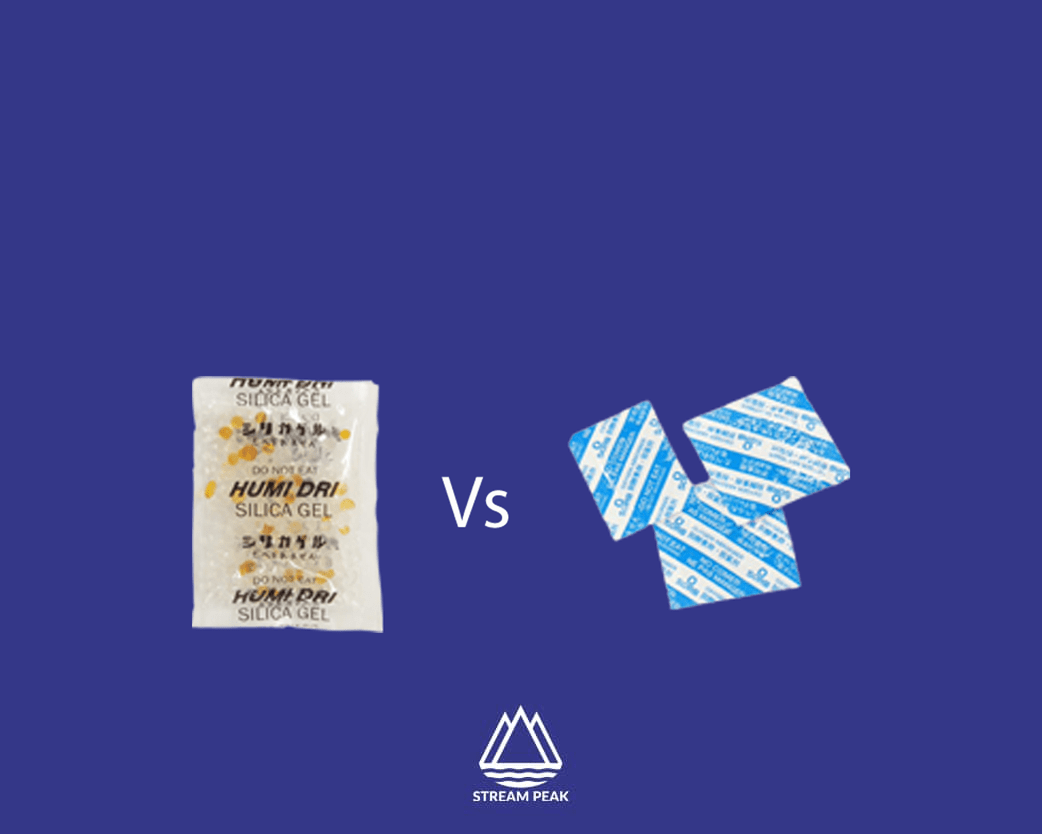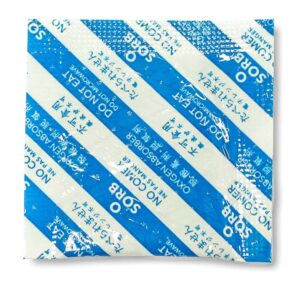Silica Gel vs Oxygen Absorber

Silica gel and oxygen absorbers are food packaging solutions to protect and preserve products, but they work in different ways and are used for different purposes. The two packaging materials often need clarification as they look similar. It is important to use the appropriate product for each specific application and to follow the guidelines provided with each product to ensure safe and effective use. This article will explain the difference between silica gel and oxygen absorbers.
Silica Gel
Silica Gel is a porous form of silicon dioxide and comes in small packets that can absorb the moisture of up to 40% of its weight. The moisture absorber can be placed in packaging or containers to prevent condensation and keep products dry in damp and humid conditions. This chemical’s ability to combat moisture prevents mould from growing can is packed together with moisture barrier bags, vitamins, shoes and electronics. As a type of desiccant, the moisture absorber can be used with dried food to help retain the product’s crispness and hardness. Find out more about silica gel here and how much desiccant bags to use in a packaging.
Applications of silica gel:
- Camera and video equipment
- Drying flowers
- Photos
- Gun cases and ammunition cans
- Non-prescription and prescription medicines
- Toolboxes
- Seed packets
- Important documents
- Reduce mould on shoes
- Luggage
Unlike oxygen scavengers, silica gel desiccant is reusable by spreading the desiccant on a baking sheet and placing it in a preheated oven at 250°F (120°C) for about 1-2 hours. Monitor the silica gel during this time to prevent overheating or burning. The heat from the oven absorbs moisture from the desiccant, which reactivates the silica gel. After the reactivation, place the desiccant bag in a zip lock bag to keep moisture at bay, and it will be ready for use when needed.
Advantages of Silica Gel
Silica gel is widely used across many industries and has a number of benefits and uses, including:
- Not flammable, non-toxic and chemically unreactive
- Reusable
- Suitable for conventional packing
- Able to absorb approximately 40% of humidity or oxygen of its weight
- Available in various sizes for different applications
- Of indefinite shelf life when stored in the right conditions
- Eliminate odour
Disadvantages of Silica Gel
Silica gel is generally safe for most people to handle and come into contact with. It is a non-toxic, non-flammable, and non-reactive desiccant to absorb moisture and keeps products dry.
- Dust from silica gel beads may cause irritation and redness when in contact with the skin and eyes
- Inhalation may cause lung irritation
- Beads can be a choking hazard for children if mistakenly consumed
Oxygen Absorbers
Oxygen Absorbers, also known as oxygen scavengers, are small packaging sachets typically made from iron powder, which reacts with oxygen to form rust, effectively removing the oxygen from the environment. The process begins when the oxygen scavenger packet is exposed to the air.
Immediately upon exposure, the iron fillings oxidise, forming rust and absorbing oxygen. This helps to prevent oxidation and the growth of aerobic bacteria, which can cause spoilage in certain products, particularly food.
Some things to know when using oxygen absorbers:
- Avoid exposing oxygen absorbers to the air; frequent exposure will reduce the lifespan
- Once the packaging is opened, take out what is required and store the rest in an airtight jar
- Use the appropriate amount for the specific product and packaging. Different products require different amounts based on their oxygen content and the packaging volume.
- Use airtight or vacuum-sealed packaging to prevent oxygen from entering and re-oxidizing the product.
- Store the materials in a cool, dry place away from moisture and direct sunlight to maintain their effectiveness.
Oxygen absorbers come in various sizes, typically from 20 cc to 500 cc. For a 5-6 gallon storage bucket, two 500 cc oxygen absorber agents should be sufficient. Oxygen absorbers protect foods such as nuts and snacks, whole-fat dry foods, processed, smoked and cured meats, dairy products, mooncakes, spices and seasoning, and flour products. They are also used for other types of food, such as fresh and precooked noodles, pet food, pastries, candies and confectioneries, coffee, tea, dried fruits and vegetables.
Common Mistakes When Using Oxygen Absorbers
Oxygen absorbers begin to work as soon as they are exposed to air. A common mistake is to open the packet too soon and fail to place the absorbers in a sealed container quickly. This is a problem as the packet will be statured and needs to be replaced with a fresh oxygen scavenger. Another mistake is using expired absorbers, which can be checked by observing the indicator’s colour.
Most oxygen scavengers’ packaging contains a little pink paper that turns blue if the oxygen scavenger has expired or is no longer useful. Another method of checking is to shake the packet. If one can hear and feel the loose powder, it’s good to use. If it’s hard or solid, the packet is saturated and should be discarded. Always store extra absorbers carefully. Good storage practices reduce wastage and are also environmentally friendly.
Advantages of Oxygen Absorbers
Oxygen absorbers are popular for several reasons, and here are some benefits:
- Non-toxic, safe to use, and FDA approved
- Prevent colour change and infestation in food packages
- Maintain food quality, e.g., delaying discolouration and darkening in fruits and vegetables
- Maintain the quality of polyunsaturated fats and oils and prevent them from going rancid
- Extend the shelf-life of pharmaceutical products and minimise the need for some preservatives
Oxygen absorbers can effectively reduce the aerobic environment to 0.01 per cent oxygen by absorbing most of the oxygen in the packaging. This inhibits the growth of microorganisms or fungi in dairy, pastries, nuts, and fish products.
Disadvantages of Oxygen Absorbers
While oxygen absorbers are very effective, there are some potential disadvantages:
- It may affect certain products’ taste, texture, or appearance, particularly food items. While they can help extend the shelf life of certain products, they may also alter their quality.
- Able to absorb a limited amount of oxygen. If too much oxygen is present, multiple absorbers may be required, which can add to the cost and complexity of packaging
- May not be effective against certain types of anaerobic bacteria
- Unable to use with foods with high oil content
- Single, one-time use
Using Silica Gel and Oxygen Absorber Together
Silica gel and oxygen absorbers are commonly used to preserve and protect products from degradation, but they work slightly differently. Silica gel absorbs moisture, while oxygen absorbers remove oxygen from the surrounding environment. For example, in food packaging, combining silica gel and oxygen absorbers can help to maintain freshness and extend the shelf life of the food.
However, using these products correctly and in the appropriate quantities is important. If too much of either product is used, it can affect the effectiveness of the other. In addition, it is important to follow the guidelines provided with each product to ensure safe and effective use.
Conclusion
Both silica gel and oxygen scavengers are effective packaging solutions for preserving and protecting products from moisture and oxygen. Silica gel is a desiccant that absorbs moisture, while oxygen scavengers remove oxygen from the packaging environment. The choice between silica gel and oxygen scavengers depends on the product’s specific needs, such as the moisture or oxygen content and the desired shelf life.
Silica gel may be more appropriate for products sensitive to moisture or high-pressure packaging environments. At the same time, oxygen scavengers may be more appropriate for products susceptible to oxidation or spoilage caused by oxygen exposure. It is important to follow the guidelines provided by the manufacturer for each product to ensure safe and effective use. It is also important to consider each option’s potential disadvantages or limitations, such as the cost or potential impact on the product’s quality.
Ultimately, choosing between silica gel and oxygen scavengers depends on the specific needs and goals of the product. Both options can effectively extend shelf life and protect the product’s quality when used correctly. Watch the video below to learn more about the differences between oxygen absorbers and silica gel.


